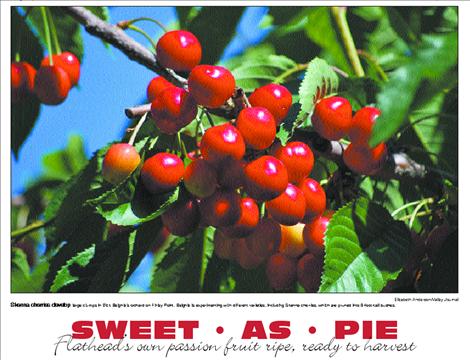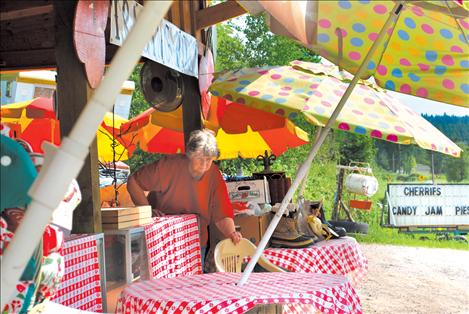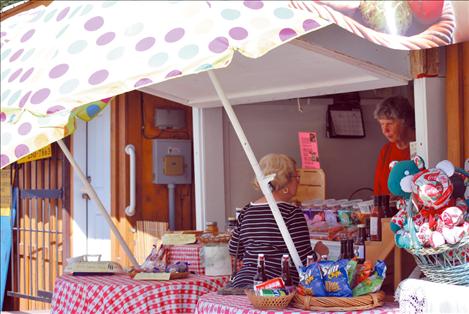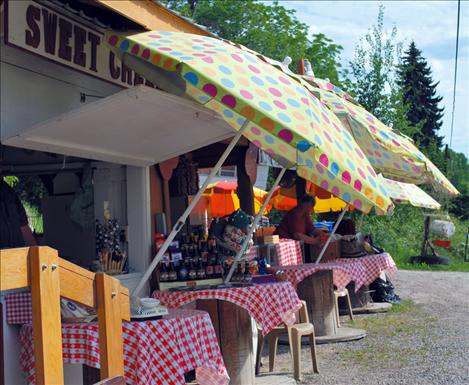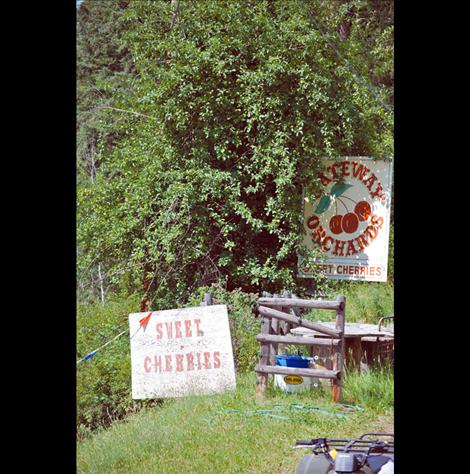Flathead’s own passion fruit ripe, ready to harvest
Hey savvy news reader! Thanks for choosing local.
You are now reading
1 of 3 free articles.
Warm summer days ripened a variety of local
cherries just in time for the Cherry Festival this year, allowing growers and vendors to sell a portion of their crop downtown last weekend.
Bruce Johnson, president of Flathead Lake Cherry Growers, a Montana Agricultural Cooperative, said that the growers were on track this year to have a pretty normal crop, volume-wise, and perhaps a little higher than last year.
“We’re getting into the one and a half to two million pounds,” Johnson said. “The average is a little more than that, but with the cold winter we were holding our breath for a while for a good crop of fruit.”
Cherries grow well in the Flathead Valley because of the climate. The 40- to 50-degree night temperatures along with the warm days provide the non-citrus fruit a prime environment during the summertime.
Johnson explained that the change in temperature allows the cherries to do well here in general.
“The lake is a heat sink. In the winter when the lake doesn’t freeze, the weather comes across the lake and allows it to stay warmer than the rest of Montana,” he said. “The heat in the summer helps ripen the fruit a little quicker."
The Flathead Valley can be harvesting anywhere from mid-July to mid-to-late August, according to Ken Edgington, media director for the Co-op board.
“The thing you’ll find its hard to say one shoe fits all. We have so many microclimates. It can be raining in Blue Bay and sunny in Yellow Bay.”
He explained that this affects when cherries actually ripen.
Polson, being on the south end of the lake, is usually the first to start harvesting cherries while Woods Bay is usually the last.
Yellow Bay has a heavy crop this year, Blue Bay has a decent crop, and Finley Point is on the lighter side but still considered a pick-able crop, according to Brian Campbell, field representative for Monson Fruit Company. “There were fewer flowers because of the hard winter in some areas, but there was a minimal amount of damage to the crop itself,” he said.
While weather can affect the outcome of a crop, the care growers give the trees also contributes to the orchard’s success.
Dick Beighle, Co-op board member, said the tricky part with growing cherries is that they have to have a lot of leaves. The leaf takes sunlight and turns carbohydrate in the leaf. The carbohydrate goes down the stem and back into the cherry, and that’s what grows the cherry.
“Taking care of the leaves is important so the cherry will grow around the pit with the right nutrients, and controlling the leaves is done through pruning,” Beighle said. “You have to learn how to prune. If you don’t do that right you’re never going to get anywhere. The harder you prune them the better they are.”
Beighle sometimes spends two to three hours a day pruning.
Growers also look for good “clumping,” a large grouping of cherries.
Beighle explained that this year’s great clumping happened because of the wonderful bee pollination that continued for about two weeks.
When the clumps of cherries can’t all grow, they are called a “cull,” when some stay small, yellow, and don’t reach full maturity.
The pickers come in and pick everything, including the under-grown cherries, according to Beighle.
“You don’t want very many of these or it cuts into profit tremendously,” he said. “Bees can be a problem too. They bite the cherry, and that little hole will make the cherry a ‘cull.’”
He said that last year, 8 percent of cherries were tossed because of a bite.
“Even if a cherry is a cull it is still edible. They are good to make jam, jelly, juice and pies,” Barbara Kaye said, who owns Gateway Orchards off Highway 35 and was part of the co-op in the ‘80s.
Kaye has owned her orchard for 36 years, and puts time in from early April to October every year.
“On this end of the lake I have basically Lambert cherries. That’s the famous Flathead Cherry,” she said.
While the climate is ideal for cherry growing, Kaye explained that sometimes winter frost kills trees that have already begun to come out of their dormancy period.
“In ’89 we had what you call an Alberta Clipper,” Kaye said. “We had a freeze from Blue Bay north. It was dropping from 40 degree weather down to 40 below within hours, and that’s why the freeze took so many trees.”
They lost roughly 250 producing trees out of 600 in the orchard when the bottom limbs froze, and now have about 450. The Lambert cherry remains their main crop, and some of the trees are 80 years old.
“Some of them look pretty sad, but they are still producing,” Kaye’s son Jimmy Engelsberger said.
In addition to cold weather, rain can also be a potential hazard.
When water sits on top of a cherry at the stem, it can soak in and split the skin. The temperature of the cherry when the water hits it is inevitably what causes the split, according to Kaye.
“A lot of people have the misconception that the sun splits the cherry,” Kaye said, “but the cherry is hot, so the water will go down into the cup and the stem. Like you’re taking a cold drink of water when you’re really hot. That’s what causes them to split.”
Nearly all the cherries grown in Montana grow in the Flathead.
The three main varieties include the Lambert, the Lapin and Sweetheart.
“The Sweetheart is one of the hopes for the future around here,” Beighle said. “It was put in as an experiment, but each tree is different.”
The Sweetheart has proven to be a good sized cherry in what is considered the “later variety family,” meaning it produces later in the season. Because Sweetheart cherries have a delayed ripening, they are also on the drop side of the market. When other cherries are running out, the Sweetheart is ready to go.
“The idea is to find some fruit that comes on later, and that’s what the Sweethearts are designed for,” Edgington said.
New varieties are beneficial for many growers to have cherries that come in later and get the price back up for the Montana market.
Beighle has 13 varieties in his 10-acre orchard on Finley Point.
“I’m kind of an experimenter,” Beighle said. “You have to have location with a lot of sun, and this seems to be ideal.”
While it takes years to perfect a new variety, the cold killed so many Lambert trees that a new later-maturing variety began to take their place, according to Beighle.
“Up until then almost everybody had (Lambert’s). People started replacing them with the Lapin cherry, which is a cross variety. They mature later and are thought to be a little more rain resistant,” Beighle said.
“It’s difficult for some Lambert owners, but if they want to survive they will have to take the Lamberts out and put in cherries that produce later on.”
Oregon and Washington have experimented with cherry bushes as opposed to trees for the last decade, to get more production in an acre.
Cherry bushes are simply cherry trees with the tops are cut off, and they are planted closer together and maintained at eight feet high by eight feet wide.
“So the last ten years we’ve been experimenting with making a bush,” Beighle said. A large part of his orchard contains bushes with Skenna cherries.
“They are really productive and you can get a lot of cherries off the bushes,” he said. “It’s working here for us. We have 550 that have quite a ways to go.”
There’s almost nothing that isn’t a mixture of breeds, according to Beighle. “Anymore, they’re all hybrid,” he said.
Many of these are coming from Washington, Vancouver and British Columbia, and Beighle explained that through the Agricultural Department in Kalispell, five orchards participated in forming a test plot within their orchards.
“Each put the six same varieties along the east shore, one by Lakeside. The study is trying to see whether we could find a better variety for the Flathead,” he said.
This is the first year for any of those trees to bear fruit, and he noted that two of them have started producing early in his orchard.
Among these is the Hudson cherry, a variety New York, and the Cantina cherry.
Other trees in his test plot are so experimental that they don’t have a name, just a number. Experimental trees don’t always produce very many cherries.
“The birds like to eat them,” he said.
Further down the row was a more advanced cherry he called the Attika.
“You can see Attika loves it here. In Oregon they’re planting them; Asians think its the best cherry they’ve ever eaten, wineries are asking for them for cherry wine,” he said, “I put 44 in this spring, and I’m thinking to use them in the farmers market.”
Other varieties include the Black Republican, Deacon, Stark Golden Yellow Cherry and the Rainier, which is well known for its sweet, sugary flavor and rosy-gold flesh.
With the cherry harvest beginning to get underway, some stands are now offering fresh Flathead Cherries along Highway 35 and Highway 93. Roadside sales usually continue for two to three weeks.
(Editor’s note: This is part one of a three part series on Flathead cherries. Still to come: History of cherries in the Flathead, the Cherry Grower’s Co-op, and changes in growing regulations.)















